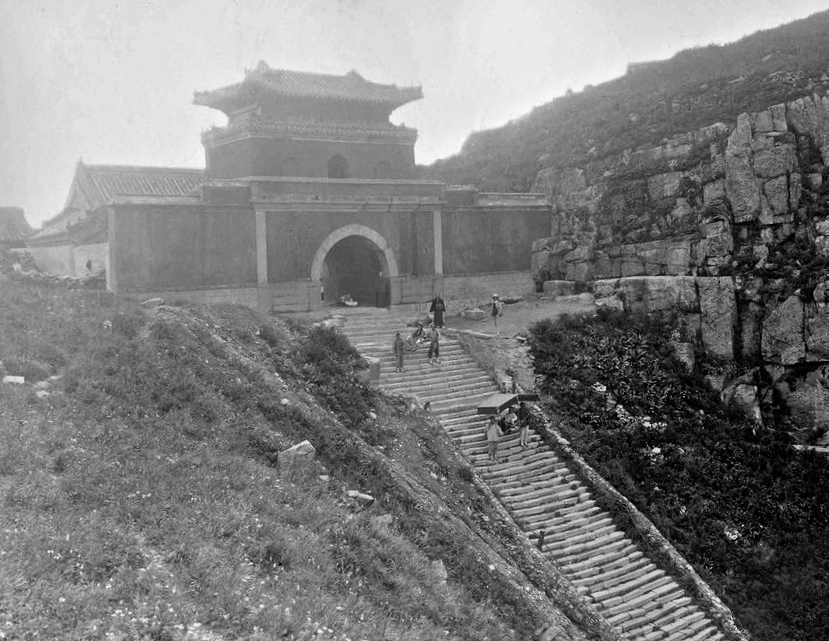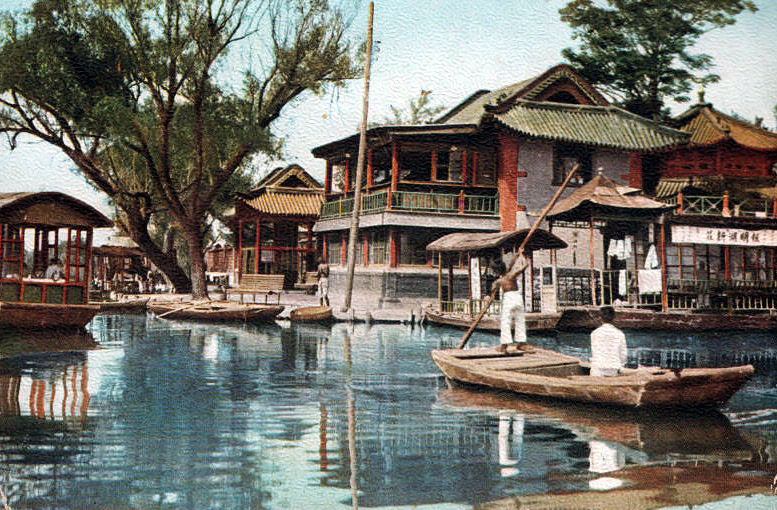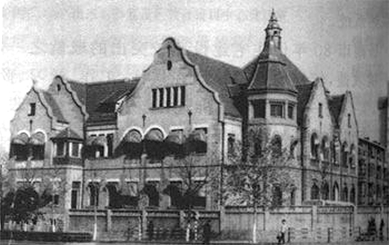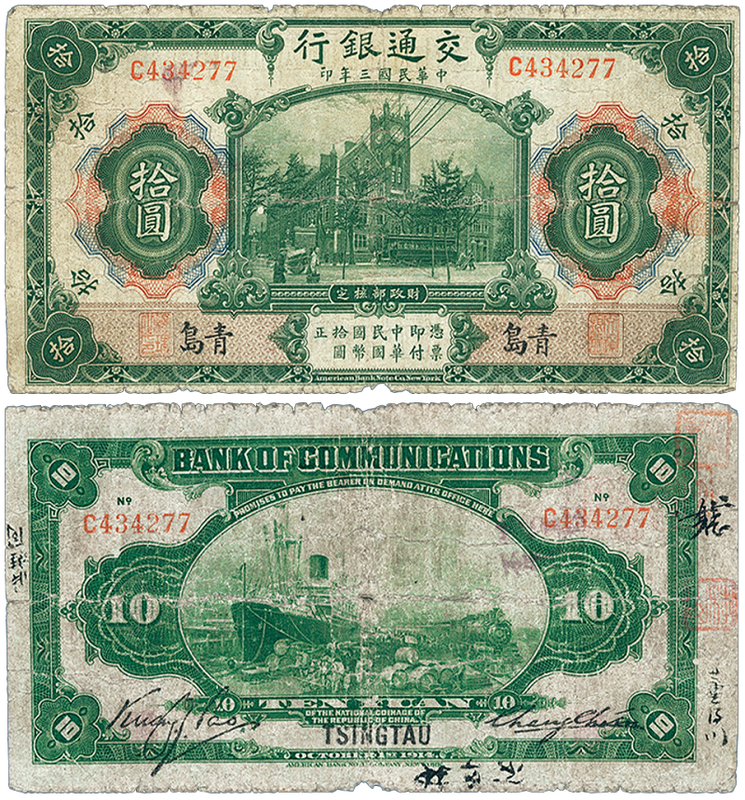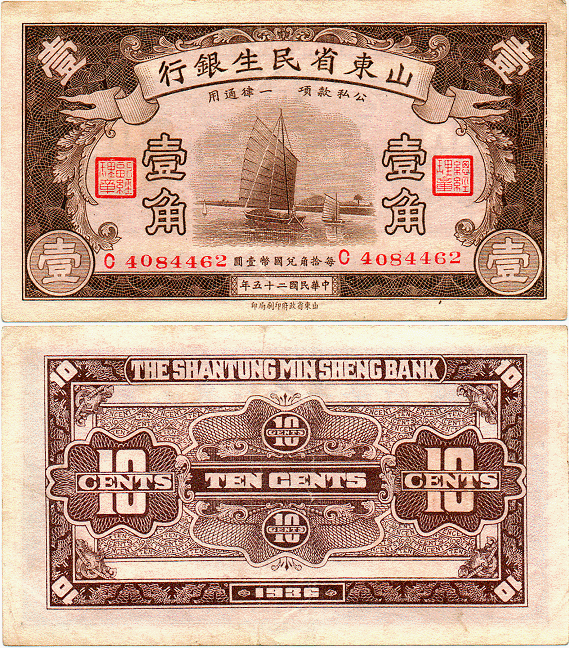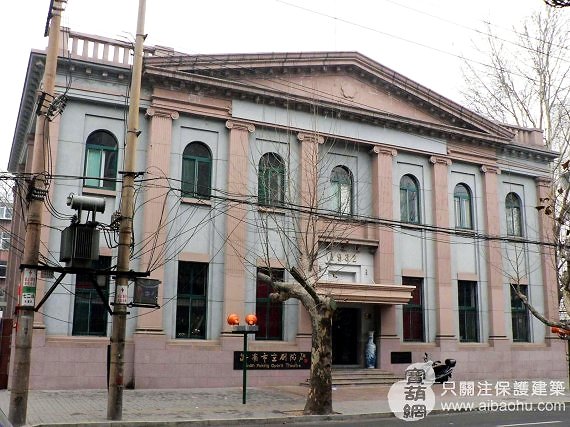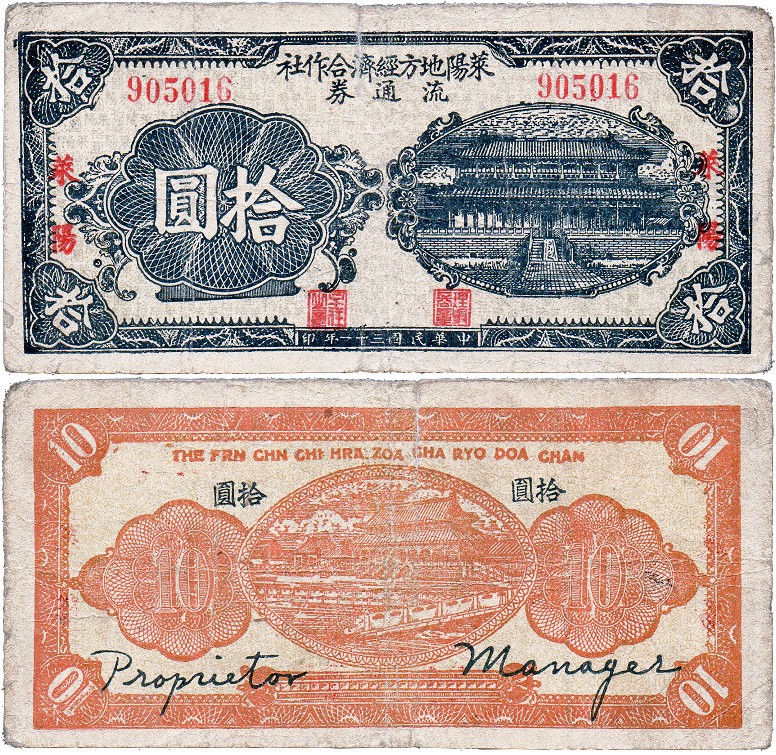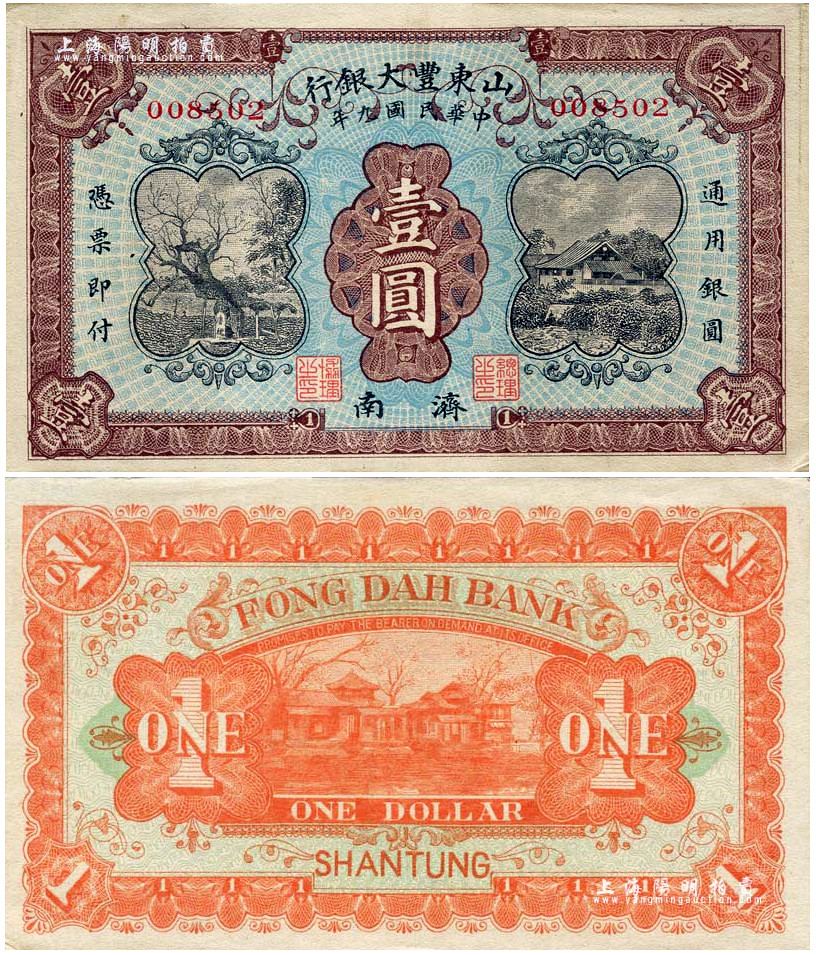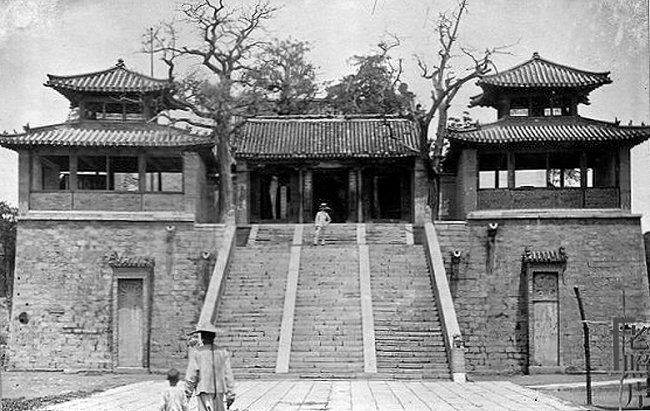Shantung - Shandong - 山東 |
Updated January 29 2018
|
|
Shantung (Shandong) is a coastal province of China and one of the country's most important economic and cultural-historical regions, sometimes referred to as a 'cradle' of Chinese civilisation. The capital is the ancient city of Tsinan (Jinan).
The name Shantung translates as 'east of the (Taihang) mountains' and was first used during the 12th century. The region was the base of successive neolithic cultures including such as the Houli (6500-5500 BC) and was populated from long before even this. The first (historically confirmed) Chinese dynasty, the Shang (1750 BC– c1027 BC) ruled over part of the region. |
|
During the Warring States period (c.475 BC - 221 BC), Shantung was controlled primarily by two states: Qi at Linzi and Lu at Qufu. Lu during this period was the birthplace and home to both Confucius and Mencius. Left: the finial for a staff of the Warring States Period. Bronze with gold and silver inlay, H. 10 × W. 22 cm. (Kong Residence Cultural Relics Archive, Cultural Relics Administrative Committee of Qufu City, Shandong Province). Through the conquests of the Qin Emperor, Shantung became part of the first centralised Chinese state. After the end of the Jin Dynasty (265–420 AD), control of the region wavered between different dynasties |
and factions - including invading nomads from the north - until the Sui Dynasty restored order in 589. Later, the Jin (Jurchen) Dynasty (1115-1234) took control of Northern China including Shantung from the Song Dynasty. Buddhism and Taoism thrived during this period. The Grand Canal was completed in 1293 which further enhanced the region as a centre of trade.
The province formally came into being during the Ming Dynasty (1368–1644), and then assumed more or less it's current state in the mid 17th century, during the early Qing Dynasty (1644-1911).
The province formally came into being during the Ming Dynasty (1368–1644), and then assumed more or less it's current state in the mid 17th century, during the early Qing Dynasty (1644-1911).
During the late 19th century, Britain and Germany in particular took control of significant parts of the province including the cities of Tsingtao (Germany) and Weihai (Britain). Germany constructed a railway, a military fort and naval base, and developed several coal mines. Unsurprisingly, the growing influence and interference of foreigners in Shantung and China as a whole, saw this region become one of the principle sources and centres of the Boxer Rebellion of 1899-1901. The infamous Qing general and politician Yuan Shikai was appointed as Governor of Shantung during this period to suppress the uprising.
Shortly after the outbreak of the First World War, Germany lost control of it's Shantung territories; despite protestations from the Chinese Government, the 1919 Treaty of Versailles transferred the German concessions in Shandong to Japan instead of restoring Chinese sovereignty over the area. Popular outrage at this outcome led to the May Fourth Movement. In 1922, US led negotiations between China and Japan led to the region finally being handed back to Chinese control. However, in reality control fell more to Chinese warlords than the Chinese government. Among the worst of these was the warlord Zhang Zongchang, nicknamed the "Dogmeat General", installed as military governor of Shantung Province in 1925. Time magazine dubbed him as China's "basest warlord", a contemporary described him as having “the physique of an elephant, the brain of a pig and the temperament of a tiger”. He ruled over the province until 1928, when he was ousted in the wake of the Northern Expedition. Throughout much of the late 1920s, to early 1930s, ordinary life in Shantung was severely disrupted.
Shortly after the outbreak of the First World War, Germany lost control of it's Shantung territories; despite protestations from the Chinese Government, the 1919 Treaty of Versailles transferred the German concessions in Shandong to Japan instead of restoring Chinese sovereignty over the area. Popular outrage at this outcome led to the May Fourth Movement. In 1922, US led negotiations between China and Japan led to the region finally being handed back to Chinese control. However, in reality control fell more to Chinese warlords than the Chinese government. Among the worst of these was the warlord Zhang Zongchang, nicknamed the "Dogmeat General", installed as military governor of Shantung Province in 1925. Time magazine dubbed him as China's "basest warlord", a contemporary described him as having “the physique of an elephant, the brain of a pig and the temperament of a tiger”. He ruled over the province until 1928, when he was ousted in the wake of the Northern Expedition. Throughout much of the late 1920s, to early 1930s, ordinary life in Shantung was severely disrupted.
The Sino-Japanese War of 1937–45
The Nationalist (KMT) general Han Fuju was made Deputy Commander in Chief of the 5th War Area and put in charge defending the lower Yellow River valley. However, he immediately abandoned his base in Tsinan (Jinan) when the Japanese troops crossed the Yellow River. Shortly after he was arrested and executed for not following orders and for possibly collaborating with the Japanese.
Japan gained control of most of Shantung by the end of 1937, though they miscalculated Chinese strength and suffered a serious defeat - their first of the war - at Tai’erzhuang, in southern Shantung, in 1938.
Shantung was occupied in its entirety by Japan - at least on paper - with resistance continuing in the countryside, and was one of the provinces where a scorched earth policy ("kill all", "burn all", "loot all") was implemented by general Yasuji Okamura.
By 1945, communist forces already held some parts of Shantung, from which they had been attacking the Japanese. Following the defeat of the latter, and soon after the failure of peace talks between Mao and Chiang, the pre-war conflict between the communists and nationalists resumed. Over the next four years of the Chinese Civil War, they expanded their holdings, eventually driving the Kuomintang government out of the province by June 1949. The People's Republic of China was founded at Peking (Beijing) in October of the same year.
Under the new government, parts of western Shantung were initially given to the short-lived Pingyuan Province, but this was undone in 1953.
The Nationalist (KMT) general Han Fuju was made Deputy Commander in Chief of the 5th War Area and put in charge defending the lower Yellow River valley. However, he immediately abandoned his base in Tsinan (Jinan) when the Japanese troops crossed the Yellow River. Shortly after he was arrested and executed for not following orders and for possibly collaborating with the Japanese.
Japan gained control of most of Shantung by the end of 1937, though they miscalculated Chinese strength and suffered a serious defeat - their first of the war - at Tai’erzhuang, in southern Shantung, in 1938.
Shantung was occupied in its entirety by Japan - at least on paper - with resistance continuing in the countryside, and was one of the provinces where a scorched earth policy ("kill all", "burn all", "loot all") was implemented by general Yasuji Okamura.
By 1945, communist forces already held some parts of Shantung, from which they had been attacking the Japanese. Following the defeat of the latter, and soon after the failure of peace talks between Mao and Chiang, the pre-war conflict between the communists and nationalists resumed. Over the next four years of the Chinese Civil War, they expanded their holdings, eventually driving the Kuomintang government out of the province by June 1949. The People's Republic of China was founded at Peking (Beijing) in October of the same year.
Under the new government, parts of western Shantung were initially given to the short-lived Pingyuan Province, but this was undone in 1953.
Tsinan - Jinan - 濟南
The modern name of the city means 'south of the Ji River'. Older texts sometimes give the name as Tsinan-fu, 'fu' being an obsolete term for a provincial capital. The area was occupied for thousands of years; during the times of the Han dynasty (206 BC – 220 AD), Tsinan was the capital of the Kingdom of Jibei. From the 5th Century, Buddhism thrived here which resulted in the development of numerous temples and other sites. Tsinan continued to flourish as a cultural centre through the Song Dynasty.
During the Civil War that followed the proclamation of Kublai Khan as Great Khan in 1260, Tsinan was at the center of a rebellion by Yizhou governor Li Tan against Mongol rule in 1262. The rebellion was crushed in a decisive battle near to the city in late March or early April 1262.
Tsinan was established as the capital of Shantung Province during the Ming Dynasty.
German influence in the city was considerable from 1897, with a new railway connecting Tsinan with their coastal enclave of Tsingtao (Qingdao), and a concession established on the western side of the city centre. During the Republican period, Tsinan developed into a major industrial and trading centre.
The Japanese established a major colony in Tsinan and increased their influence throughout Shantung Province following the decline of defeated Germany; a situation which continued even after China regained formal control of the province. By 1931, over 2000 Japanese were resident in Tsinan. A serious clash occurred between the Japanese and KMT forces in 1928 during the Northern Expedition which led to an embarrassing defeat for the latter, with over 2000 civilians killed and many thousands of soldiers killed or injured. The Japanese occupied the entire city for 6 months before withdrawing to Tsingtao in March 1929.
During the Civil War that followed the proclamation of Kublai Khan as Great Khan in 1260, Tsinan was at the center of a rebellion by Yizhou governor Li Tan against Mongol rule in 1262. The rebellion was crushed in a decisive battle near to the city in late March or early April 1262.
Tsinan was established as the capital of Shantung Province during the Ming Dynasty.
German influence in the city was considerable from 1897, with a new railway connecting Tsinan with their coastal enclave of Tsingtao (Qingdao), and a concession established on the western side of the city centre. During the Republican period, Tsinan developed into a major industrial and trading centre.
The Japanese established a major colony in Tsinan and increased their influence throughout Shantung Province following the decline of defeated Germany; a situation which continued even after China regained formal control of the province. By 1931, over 2000 Japanese were resident in Tsinan. A serious clash occurred between the Japanese and KMT forces in 1928 during the Northern Expedition which led to an embarrassing defeat for the latter, with over 2000 civilians killed and many thousands of soldiers killed or injured. The Japanese occupied the entire city for 6 months before withdrawing to Tsingtao in March 1929.
Two street views of Tsinan (Jinan) taken during the 1920s (left) and 1930s (right). It's probable but not certain whether the right hand picture was taken during Japan's wartime occupation of the city, despite the presence of the Japanese flag, as Tsinan had a sizeable Japanese community.
Han Fuju became Governor (of Shantung) from 1930, unifying the province by 1932. He established his base in Tsinan and is credited with curtailing banditry and drug trafficking, thereby bringing a brief period of peace and prosperity to the city. From the mid 1930s, he was placed under increasing pressure by the Japanese to declare independence from China. Though he declined to do so, his later defence of Tsinan and the province during Japan's 1937 invasion was less than half-hearted. He ignored direct orders to defend the city to the death and retreated. For this he was soon after executed by the KMT.
The Japanese occupied the city and province (the latter more in theory than strictly fact) until their defeat in 1945. The KMT briefly regained control only to lose the area for the final time in September 1948, defeated by Communist forces at the Battle of Tsinan (Jinan).
The Japanese occupied the city and province (the latter more in theory than strictly fact) until their defeat in 1945. The KMT briefly regained control only to lose the area for the final time in September 1948, defeated by Communist forces at the Battle of Tsinan (Jinan).
Mount Tai (Taishan)
The Confucius Estate

The Temple of Confucius in Qufu is one of the three largest ancient architectural complexes in China. Qufu (near Tsining/Jining) is the home town of Confucius; he was born and died here and his descendants have continued to live here (according to tradition) for 2,500 years after his death. Built to commemorate him in 478 B.C., the temple has been destroyed and reconstructed over the centuries; today it comprises more than 100 buildings. The Kong family cemetery in Qufu contains 78 generations of Confucius' relatives. The first born son of the 77th generation (traditionally) was driven out of China in 1948 by the Communists, and resided in Taiwan. The remaining family members survived the Red Guard attacks.
Above: The principle statue of Confucius in the main temple hall (photo c.1910s). This was sadly destroyed during the 1960s and has since been replaced/restored.
Confucius (551 BCE – 479 BCE), was a social philosopher, politician and educator, who focused upon personal and governmental morality, social relationships, justice and sincerity, and is one of the most influential people who have ever lived. The Temple started as three houses in the year of 478 BC, the second year after his death. Over time as Confucianism became ever more significant within Chinese society and culture, the scale of the Temple was expanded accordingly. Sacrifices were often offered to the sage, either by Emperors themselves, or by emperor-appointed high officials. In the Qing Dynasty (1644-1911), Emperor Qianlong offered sacrifices here eight times. The existing Temple of Confucius was rebuilt and renovated during the Ming (1368-1644) and Qing (1644-1911) dynasties and patterned after a royal palace.
For a more thorough overview of the site and a study of the several Central Bank of China series which commemorated this complex, please go to this page The Confucian Series of the Central Bank of China
Some of the Banknotes
The Bank of China - 中國銀行
|
The Bank of China's regional main branch - and branch of issue - was located in the provincial capital of Tsinan, however from the 1920s onwards only the name of the province 'Shantung' is given (though sometimes regional branch names are added later, as per the example, right) for reasons as yet unknown, though it may no doubt relate to the often turbulent nature of the region as it passed from being under the sway of German to Japanese control or influence, plus the rule of various unruly warlords. Indeed, in 1926, the Governor-Warlord Zhang Zongchang had the Tsinan branch manager placed under house arrest, and only when the bank agreed to lend the Shantung Government 500,000 Yuan did the threats against him cease (1). The Tientsin branch manager Bian Baimei noted in his diary, "actually, if we had persevered some, the amount might have decreased a little". One of the more unusual banknote issues was the so-called 'no-placename' (in English) 1 Dollar of 1913. For more information see here. Upper right: Bank of China 5 Yuan of 1918 (issued c.1922) This scarce note has been overprinted with the port city of Tsingtau specifically as the branch of issue. Right: Bank of China 5 Yuan of 1934 depicting a pailou gate at the Temple of Confucius leading to the Confucian cemetery. (back) one of several pailou gates on the route which leads to the summit of Mount Tai, plus a carved stone inscription; one of many found in the vicinity. This was a banknote issue unique to Shantung Province and was accompanied by 1 and 10 Yuan notes. Some examples are found with overprints for issue out of regional branches including Weihaiwei. Right: The German style Bank of China branch in Tsinan. The building still survives though is apparently no longer a bank.
|
The Bank of Communications - 交通銀行
|
Little information is readily available for the primary Shantung branch which was located in Tsinan. The branch office building which still survives was built in the European classical revival style in 1925 by Chinese architect Zhuang Jun (see images below). Virtually all notes were marked primarily as 'Shantung' issues (as per the example, right) - only some rare and early examples of the 1914 series are stamped with just the local branch names (as per the green 1914 10 Yuan example, below right). Many notes - especially of the 1927 series - were counterstamped for issue out of the sub-branch offices in such as Tsingtau and Chefoo. Some are indeed found stamped for issue from the Tsinan branch. Right: Bank of Communications 10 Yuan of 1914 (c.1933). |
|
Right: Bank of Communications 5 Yuan of 1927, 'Shantung' and over-stamped for issue in the provincial capital of Tsinan. The right hand signature-character on the front is of General Manager Lei Chao. Below: the main facade of the Tsinan (Jinan) Bank of Communications branch office. From c.1941-45 it was an office of the Japanese puppet 'Federal Reserve Bank of China'. Afterwards it briefly returned to the Bank of Communications, and later became a branch of the communist Behai Bank, and later still of the Peoples Bank of China.
Below right: the scarce 20 Yuan of 1924 which apparently depicts the Tsinan branch office? |
The Provincial Bank of Shantung - 山東省銀行
|
The Shantung Provincial Bank was one of at least 17 currency issuing provincial banks operating across China during the 1920s - and mostly for the purpose of funding the Warlord-Governors who weren't above using the threat of violence to ensure that their often dubious money circulated. In 1927, this bank printed and issued $55 million in currency despite only having a reserve of $1.5 million to back it (3). The warlord governor General Zhang Zongchang urgently needed this money - and the resources it provided - to supply his troops to resist the approaching armies of the KMT Northern Expedition. However the expected assault didn't finally come until 1928, and when it did, Zhang was defeated and driven out. The bank was succeeded by the Shantung Min Sheng Bank in 1932. Right: The Provincial Bank of Shantung 10 Yuan of 1925, 'Tsinan' branch issue. The front vignette depicts the summit temples of Mount Tai. |
Shantung Provincial Treasury - 山東省金庫劵
The Shantung Minsheng Bank - 山東省民生銀行
|
The successor to the Provincial Bank of Shantung, from 1932. The bank was established by Han Fuju, the governor of the province, executed in 1938 for not resisting the Japanese invasion and occupation of Shantung. The word(s) Min Sheng mean ‘people’s livelihood,’ and may have it’s origins in the popular and much publicised ideas of Sun Yatsen, the 'Three Principles of the People'; who sought to develop a balanced social system to attain economic justice and liberate the poor of China. The 1940 and previous notes were assumedly supplanted by the issues of the Federal Reserve Bank of China in or after 1941, though the subsequent appearance of a 1943 issued note is puzzling. This was presumably issued within a anti-Japanese resistance 'pocket' in the province. This bank has no relation to the modern China Minsheng Bank. Right: The Shantung Min Sheng Bank 10 Cents of 1936 Right: The former headquarters of the Shantung Min Sheng Bank in Tsinan (Jinan). The date '1932' can be seen above the main entrance door. |
Chang-Yi Sixth District Exchange Notes - 昌邑六區兌換券
|
Head Office: Weifang, Changyi County - Shantung (Shandong) "Exchange note of the 6th district of Changyi" Watson McMillan Hayes, a US missionary and teacher was imprisoned with his family at a civilian assembly centre operated by the Japanese at Weifang in 1944, showing that the area was under the control of Japan during the period of issue of these notes (a 1, 10 and 500 yuan are also known). However - there was also a communist led anti-Japanese movement operating in many areas of the Shantung (Shandong) Province during the 1940s. One Chinese source stated that these Changyi notes were issues of a liberated area (by the communists) which seems the most likely explanation, as an emergency issue for a region retaken from Japanese occupation. These notes do have allot in common with established communist issues of the period. Right: 100 Yuan of 1944. |
Laiyang Local Economic Cooperatives Exchange note - 莱阳地方经济合作社流通券
|
Head Office: Laiyang, Yantai (nr. Tsingtao). Shantung province. Exchange notes issued by the administration of Laiyang and surrounding counties. These notes seem to have been issued under the control of the anti-Japanese/anti-communist military commander General Zhao Baoyuan (赵保原 - Commanding Officer Jiaodong Guerrilla District, Jiangsu-Shandong War Zone), operating on behalf of the Shantung Provincial Government. He was posted to Shantung in 1938 by the Japanese, avoided fighting and led his brigade in a mutiny to join a anti-Japanese coalition in November 1938. Due to the value of his forces, Chiang Kai Shek appointed him as acting Governor of Laiyang County in February 1939. He initially worked with the communists, however disagreements led to his participation in an anti-communist coalition. He later reconciled with the Japanese - to some degree. (2) The issue of this currency was partly motivated by the need to fund armies, and due to the shortage of national and provincial currency. This currency seems have have severely devalued by 1944 and was obsolete by 1945-46. Right: The 10 Yuan of 1942. There are two versions. The other version has the character 建 at the top left and right of the front. The back of the note carries the titles 'proprietor' and 'manager' in the style of signatures - but no actual signatures. There is also a line of assumedly nonsense text in the roman alphabet - a string of three letter words finished by a four letter word; all purely for show. A further quirk is the top right numeral 10 of the back, which is upside down. (front) the main hall of a temple? (back) the temple courtyard. (sources: "A Springboard to Victory: Shandong Province and Chinese Communist Military" By Sherman Xiaogang Lai (p 109-110) |
Fong Dah Bank
YI Feng Hao - 益豐號 (small commercial issues)
|
Head Office: Qingzhou, formerly Yidu County (益都县), Shantung (Shandong). Right: a remainder 10 cents of 1932. An issued example observed on an auction site bares a large red seal within the space on the lower back of the note, and a western style signature in the upper curved space above the amount. The vignette depicts Beijige Daming Lake Temple in Tsinan (see below). This subject is found on many of these types of notes but by diverse issuers and printers. |
The Beiji Temple ("North Pole Temple") overlooking Daming Lake in Tsinan. A Taoist temple dedicated to the God of the North, Xuan Wu, first built during the Yuan Dynasty and rebuilt in the Ming. The temple was renovated during the late Qing dynasty. The temple was mostly or completely destroyed during the Cultural Revolution and has since been rebuilt. Taken from a distance, the right image shows the roof of the main hall of the temple which is often obscured in images.
Sources:
(1) Trust in Troubled Times: Money, Banks, and State-society Relations in Republican Tianjin. By Brett Sheehan. (p 101). Harvard University Press, 2003
(2) "A Springboard to Victory: Shandong Province and Chinese Communist Military" By Sherman Xiaogang Lai. (p 109-110).
(3) Warlord Politics in China: 1916 - 1928, (p161-162) Stanford University Press, 1976
(1) Trust in Troubled Times: Money, Banks, and State-society Relations in Republican Tianjin. By Brett Sheehan. (p 101). Harvard University Press, 2003
(2) "A Springboard to Victory: Shandong Province and Chinese Communist Military" By Sherman Xiaogang Lai. (p 109-110).
(3) Warlord Politics in China: 1916 - 1928, (p161-162) Stanford University Press, 1976


